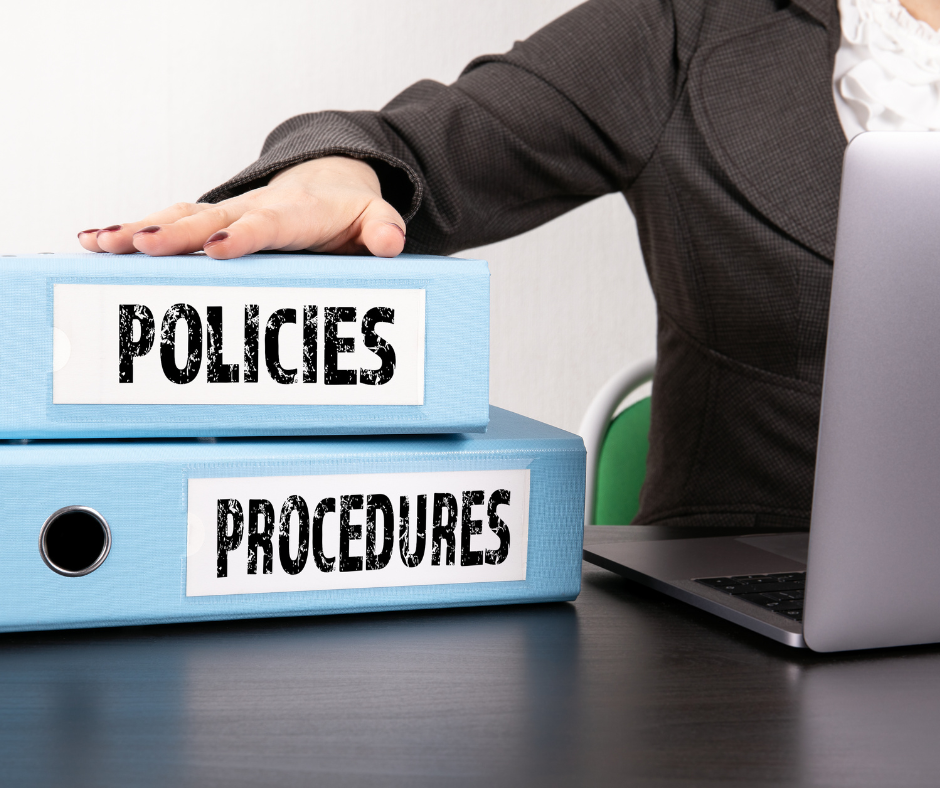
Are you familiar with your company’s policies and procedures at workplace? Knowing the rules and expectations within your workplace is crucial for maintaining a positive and compliant work environment. Our essential guide will enlighten you on the importance of workplace policies and procedures, their development, key policies to implement, effective management and communication, as well as legal compliance and risk management.
Key Takeaways
- Understanding workplace policies and procedures is essential for employers and employees.
- Policies define expectations, while procedures provide steps to fulfill them. They are integral to daily operations.
- Developing effective policies requires alignment with company values, stakeholder involvement, regular reviews/updates & legal compliance for risk management.
Policy for Working Remotely
Our “Policy for Working Remotely” is designed to provide clear guidelines and expectations for employees engaging in remote work. As part of our commitment to flexibility and work-life balance, this policy outlines the parameters for remote work arrangements, including communication protocols, productivity expectations, and security measures. We believe that a well-defined remote work policy ensures a harmonious balance between employee autonomy and organizational goals. Adhering to the “Policy for Working Remotely” ensures a consistent and productive remote work experience for all team members.
Understanding Workplace Policies and Procedures
Workplace policies and procedures play a vital role in the smooth operation of any organization. Whether it’s ensuring employee behavior aligns with company values or maintaining compliance with employment laws, a clear understanding of these guidelines, including each specific workplace policy and workplace procedures, is essential for both employers and employees.
So, what exactly are workplace policies and procedures, and how do they differ from one another? We’ll discuss the basics next.
 Policies vs. Procedures
Policies vs. Procedures
Policies provide general guidelines that define expectations and acceptable behavior within the workplace, while procedures outline specific action plans for implementing these policies. For instance, a social media policy may set expectations regarding acceptable use of social media in the workplace, while the procedure would describe the steps employees should follow to comply with the policy. To better understand these guidelines, a policy explain document can be provided to employees for clarity.
Distinguishing between policies and procedures boosts clarity about rules and expectations, fostering a harmonious work environment.
The Role of Policies and Procedures in Day-to-Day Operations
Policies and procedures serve as the backbone of an organization’s day-to-day operations. They help establish rules, set expectations, and ensure the organization’s vision and values are integrated into everyday activities. For example, a health and safety policy outlines the guidelines for maintaining a safe work environment, while a harassment policy ensures fair treatment for all employees, regardless of their background.
Embedding these guidelines into daily operations cultivates a positive work culture, benefiting employees and promoting productivity and growth.
Developing Effective Policies and Procedures

Developing effective policies and procedures is a vital aspect of managing a successful organization. Aligning these guidelines with company values, involving stakeholders, and conducting regular reviews and updates are essential steps in this process.
We’ll examine these aspects more closely next.
Aligning with Company Values and Vision
Aligning policies and procedures with company values and vision promotes consistency and fosters a positive organizational culture. For example, if communication is a core value, workplace policies can include guidelines for effective communication among employees and departments.
Incorporating company values into workplace policies reminds employees of their importance, and putting company policies into practice encourages them to uphold these values in their daily work.
Involving Stakeholders
Involving stakeholders in the development of policies and procedures is crucial for ensuring their relevance and effectiveness. Stakeholder input can lead to:
- Improved decision-making
- Heightened buy-in and support
- Greater transparency and accountability
- Recognition of potential issues and risks
Engaging stakeholders in the development process allows organizations to build policies and procedures that are practical and beneficial for all involved parties.
Regular Reviews and Updates
Regularly reviewing and updating policies and procedures is essential for maintaining their effectiveness in addressing emerging issues and changes in the business environment. It is recommended that organizations review their policies and procedures at least annually, or every one to three years, to ensure they remain current and relevant.
A proactive approach like this can avert potential issues, help sustain a compliant and harmonious work environment, and prevent the need for disciplinary action.
Key Workplace Policies to Implement

Now that we’ve covered the importance of policies and procedures, let’s focus on some key workplace policies that every organization should implement. These include employee conduct and behavior, health and safety guidelines, and equal opportunity and anti-discrimination policies.
Employee Conduct and Behavior
Employee conduct and behavior policies, including attendance policies, set the tone for acceptable behavior in the workplace. These policies, such as a dress code or social media use policy, reflect the company’s values and help maintain a professional work environment.
Establishing clear behavioral expectations can help organizations maintain a productive and respectful workplace.
Health and Safety Guidelines
Health and safety guidelines are critical for protecting employees and employers from accidents and safety incidents. These policies not only help maintain a safe and healthy work environment but also promote compliance with relevant laws and regulations.
Implementing comprehensive health and safety policies minimizes the risk of workplace accidents and fosters a culture of safety for all employees.
Equal Opportunity and Anti-Discrimination
Equal opportunity and anti-discrimination policies are essential for promoting fair treatment and diversity in the workplace. By adhering to these policies, organizations can ensure they comply with relevant laws and regulations, such as those enforced by the Equal Employment Opportunity Commission (EEOC). Implementing these policies not only helps create a welcoming and inclusive work environment but also protects the organization from potential legal issues.
Overtime Policy
Our company’s commitment to maintaining a fair and effective work environment is reflected in our comprehensive overtime policy. Employees should be aware of the guidelines outlined in the overtime policy to ensure transparency and adherence to the established rules. We prioritize the well-being of our team members and recognize the importance of balancing workload demands with individual health and productivity. Clear communication and understanding of the overtime policy are essential for fostering a positive work culture and ensuring that our employees are fairly compensated for their additional efforts. Our aim is to create a work environment where everyone can thrive while maintaining a healthy work-life balance
Managing and Communicating Policies and Procedures

Effectively managing and communicating policies and procedures is critical for ensuring that employees understand and adhere to the established guidelines. This can be achieved through the use of an employee handbook, training and support, and policy management software.
We’ll expand more on these methods next.
Employee Handbook
An employee handbook serves as a centralized source for communicating company policies and procedures to employees in a written format. Consolidating all relevant information into one accessible document allows employees to easily reference the handbook as needed. This not only helps maintain consistency in policy enforcement but also ensures that employees are aware of the expectations placed upon them.
Training and Support
Providing training and support on workplace policies and procedures is essential for ensuring that employees understand and adhere to the established guidelines. Training sessions can be conducted periodically to keep employees up-to-date on any policy changes and reinforce the importance of compliance.
Additionally, ongoing support, such as access to resources or designated personnel for policy-related questions, can help employees feel confident in their understanding of company policies and procedures.
Policy Management Software
Policy management software can greatly assist in the centralization, distribution, and updating of policies and procedures. Automating policy distribution guarantees that all employees have access to the latest information. Some software also offers tracking features, such as electronic signatures, to confirm that employees have read and understood the policies.
Utilizing policy management software can help promote legal compliance and efficient communication of workplace policies and procedures, making it easier to implement such a policy.
Legal Compliance and Risk Management

Adhering to employment laws and implementing risk management strategies are essential components of maintaining a compliant and successful organization. In this section, we’ll examine the significance of compliance with employment laws and delve into risk assessment and mitigation strategies.
Adhering to Employment Laws
Complying with employment laws, such as labor standards and anti-discrimination regulations, is crucial for protecting the organization from legal issues and promoting a fair work environment. For instance, organizations must adhere to the Fair Labor Standards Act (FLSA) for minimum wage and overtime pay, as well as the Americans with Disabilities Act (ADA) to prevent discrimination against employees with disabilities.
Ensuring compliance with these laws allows organizations to maintain a positive and equitable work environment for all employees.
Risk Assessment and Mitigation
Risk assessment and mitigation strategies involve:
- Identifying potential issues
- Implementing appropriate measures to minimize risks associated with workplace policies and procedures
- Conducting regular risk assessments
- Evaluating the likelihood and impact of potential risks
- Implementing strategies to reduce or eliminate these risks
Proactively addressing potential issues helps organizations create a safer and more compliant work environment for all employees.
No Recording Policy Template
In adherence to our commitment to fostering a secure and respectful work environment, we have established a comprehensive “No Recording Policy Template.” This policy template outlines the guidelines and expectations regarding the prohibition of any audio or video recording within the premises without explicit consent. As an integral part of our commitment to privacy and confidentiality, this template ensures that all employees understand the importance of maintaining a secure and comfortable atmosphere for everyone. It outlines the procedures for handling potential violations and serves as a valuable resource to uphold our standards of professional conduct.
Summary
In conclusion, workplace policies and procedures play a vital role in the smooth operation of any organization. By understanding their importance, developing effective guidelines, implementing key policies, managing and communicating these policies effectively, and ensuring legal compliance and risk management, organizations can foster a positive and compliant work environment. Remember, a harmonious workplace starts with clear expectations and a thorough understanding of the rules and regulations that govern it.
Frequently Asked Questions
What are examples of policies and procedures?
Policies are an important part of any workplace and can include codes of conduct, recruitment policies, internet and email use policies, mobile phone policies, non-smoking policies, drug and alcohol policies, health and safety policies, and anti-discrimination and harassment policies. Procedures provide a way to ensure that the policies are followed.
What is the difference between policies and procedures?
Policies outline general expectations and acceptable behavior, while procedures provide step-by-step action plans for implementing those policies.
How often should workplace policies and procedures be reviewed and updated?
Organizations should review their policies and procedures annually or every one to three years to keep them current and relevant.
What key workplace policies should be implemented in an organization?
Employees should be expected to adhere to a code of conduct and behavior, while employers should take all necessary steps to ensure a safe working environment and protect against any form of discrimination.
What is the role of training and support in managing workplace policies and procedures?
Training and support play an important role in ensuring employees understand and adhere to workplace policies and procedures, providing guidance and accountability that create a positive and compliant work environment.